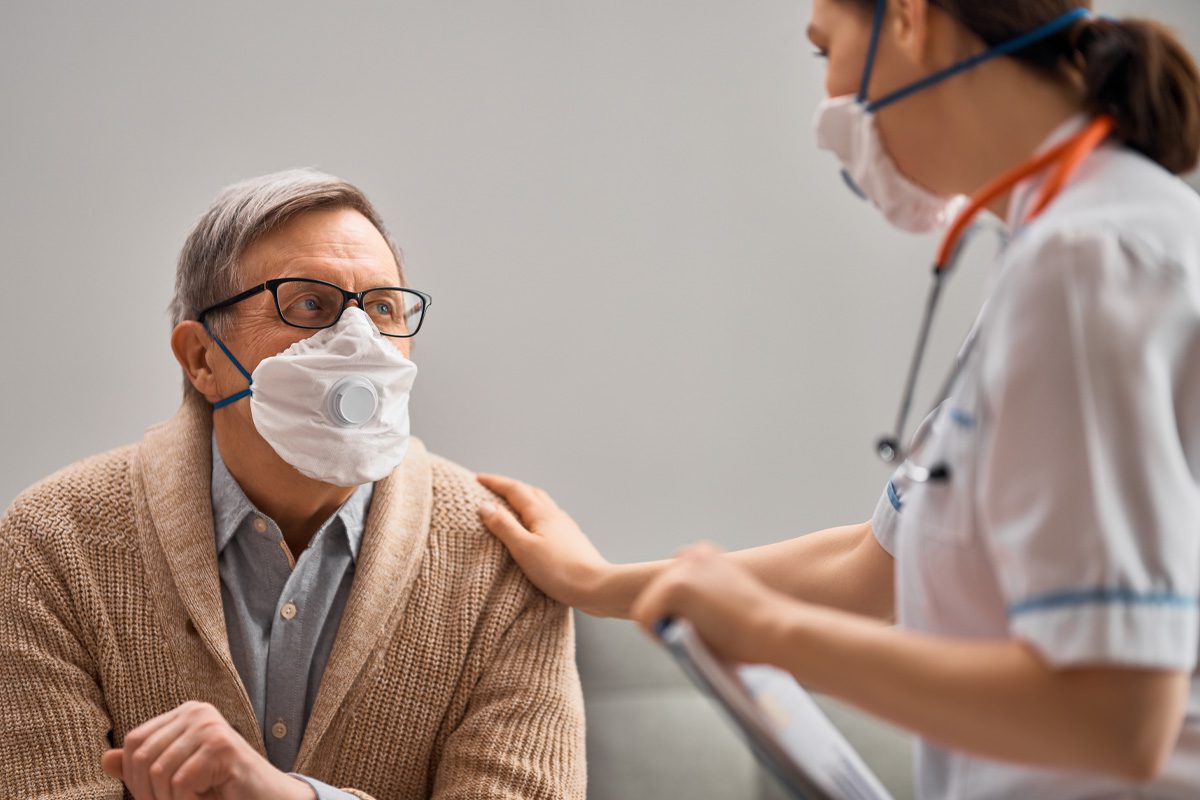A variety of measures are needed to prevent the spread of the coronavirus SARS-Cov-2 in nursing homes, and it is particularly important to develop a strategy to protect healthcare workers from airborne transmission. A recent article on this topic appeared in The International Journal of Environmental Research and Public Health, with expert contributions from the Leipzig Institute for Tropospheric Research (TROPOS), the CSIR National Physical Laboratory in New Delhi, the Institute of Atmospheric Science and Climate in Rome, and 2B Technologies in Colorado. The key recommendations are summarised here.
More attention must be devoted to indoor air in such facilities and to training staff. From an aerosol experts’ point of view, it is necessary to combine a number of measures.
These include regular ventilation, controlling fresh air consumption via CO2 monitoring, and using humidifiers to keep the relative humidity indoors at 40 to 60 percent. If it is not possible to ventilate sufficiently, the use of portable air purifiers is also advisable.
The risk of infection is particularly high in hospitals and nursing homes because infected and healthy people stay in the same room for long periods of time and the virus can be transmitted via invisible aerosol particles in the air, even over distances of several metres. According to media reports, COVID-19 infections are already reported in almost one tenth of the 12,000 old people’s homes and nursing homes in Germany.
Since the pandemic began, there have been increasing reports of transmissions via aerosol particles in the indoor air of hospitals and nursing homes. In a nursing home in the Netherlands, the virus apparently spread via the ventilation system. SARS-CoV-2 was detected on the dust filters of the air conditioning system. The complexity of the aerosol transmission of SARS-CoV-2, especially indoors, is far from understood and there is a need to establish appropriate guidelines to protect medical staff, according to Prof Alfred Wiedensohler from TROPOS.
The aerosol spread of the virus is, according to many experts, a major reason why the number of corona infections in Europe increased dramatically in the autumn. People stay indoors for longer durations and as temperatures fall, many indoor spaces are much less ventilated. Concentrations of viral particles in the air can rise sharply when infected people stay indoors. Simple mouth-nose masks can significantly reduce but not completely prevent the release of viral aerosol particles from individuals. The risk therefore increases significantly with the number of people present and the length of time they stay in the room. Even greater risks arise with medical procedures such as intubation, where a lot of aerosol is produced.
The spread of viruses via the room air can be reduced with a number of measures. Since there is no single measure that can achieve this completely, it is important to control indoor air and combine different measures:
As protection against the transmission of SARS-CoV-2 via the air in closed rooms, especially in cold and dry weather, the authors recommended humidifiers to keep the relative humidity in the room in the range of 40 to 60 percent and to reduce the risk of respiratory tract infection. It is in this middle range that the human mucous membranes are most resistant to infections. In addition, the viruses in the aerosol particles can survive at a relative humidity around 50 percent for less time than in drier or high humid air, according to Dr Ajit Ahlawat of TROPOS.
It is very important that there should be a constant supply of fresh air through the air conditioning system or ventilation. This can be controlled with measuring devices for CO2. Indoor spaces have high levels of CO2 because there is lot of exhaled air in the room. If there is an infected person in the room, then there will also be many viral aerosol particles floating in the air. The Heating, Ventilation and Air Conditioning (HVAC) system should have a minimum efficiency of MERV-13 to filter even very small particles out of the air. (MERV stands for Minimum Efficiency Reporting Value and is a US standard).
If adequate ventilation is impossible, an attempt can be made to reduce the concentration of viruses in the room air by using air purifiers. These should be equipped with so-called HEPA (High-efficiency particulate absorbing) filters. Air purifiers cannot replace the supply of fresh air and thus oxygen, so can only ever be a supplementary measure.
Medical staff need special protection during procedures and surgical operations that involve potentially infectious aerosol particles – such as dental treatment or intubation. Valve-free particle filter masks, so-called respiratory masks such as N95, should be worn and care should be taken to ensure that they lie close to the skin. “Avoid the use of FFP2 and FFP3 type respirators,” advises Dr Francesca Costabile of the Institute of Atmospheric Science and Climate (ISAC) in Rome, “which have an exhalation valve or ventilation, as these types of respirators are not sufficient. To reduce the risk, protective equipment such as goggles should also be worn.” The researchers also recommend avoiding aerosol-generating procedures and treatments in patients with COVID-19 wherever possible. For example, medication administered via a nebulizer. Inhaled drugs should be administered by a metered dose inhaler instead, if possible.
Care should also be taken when disinfecting rooms, says Dr Sumit Kumar Mishra of CSIR National Physical Laboratory. “We recommend that disinfection with UV-C light should not be used too often. Although it is known that UV-C light destroys the SARS-CoV-2 viruses, it ultimately increases indoor ozone concentrations,” he said.
Spraying oxidizing chemicals such as hydrogen peroxide (H2O2) can also be a bad idea. Indoors, these chemicals cause toxic chemical reactions that create other air pollutants and damage the central nervous system and lungs of humans.
Staff shoud be trained to follow such recommendations, which could greatly reduce the risk of airborne transmission until vaccination is effective on a large scale, said the authors.







